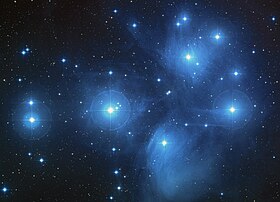| Observation data Epoch J2000 Equinox J2000 | |
|---|---|
| Constellation | Taurus |
| Right ascension | 03h 49m 11.2166s[1] |
| Declination | 24° 08′ 12.157″[1] |
| Apparent magnitude (V) | 4.77 - 5.50[2] |
| Characteristics | |
| Evolutionary stage | Main sequence |
| Spectral type | B8Vne[3] |
| B−V color index | −0.08[4] |
| Variable type | γ Cas[2] |
| Astrometry | |
| Radial velocity (Rv) | 5.10[5] km/s |
| Proper motion (μ) | RA: 19.496[1] mas/yr Dec.: −47.650[1] mas/yr |
| Parallax (π) | 7.2414 ± 0.1255 mas[1] |
| Distance | 450 ± 8 ly (138 ± 2 pc) |
| Absolute magnitude (MV) | −0.347[6] |
| Details | |
| Mass | 2.888[7] M☉ |
| Radius | 3.701[7] R☉ |
| Luminosity | 184[7] L☉ |
| Surface gravity (log g) | 3.087[8] cgs |
| Temperature | 11,058[7] K |
| Metallicity [Fe/H] | +0.02[6] dex |
| Rotational velocity (v sin i) | 290[9] km/s |
| Age | 125[10] Myr |
| Other designations | |
| Database references | |
| SIMBAD | data |
Pleione[note 1] is a binary star and the seventh-brightest star in the Pleiades star cluster (Messier 45). It has the variable star designation BU Tauri (BU Tau) and the Flamsteed designation 28 Tauri (28 Tau). The star is located approximately 138 parsecs (450 light-years) from the Sun, appearing in the constellation of Taurus. Pleione is located close on the sky to the brighter star Atlas, so is difficult for stargazers to distinguish with the naked eye despite being a fifth magnitude star.
The brighter star of the Pleione binary pair, component A, is a hot type B star 184 times more luminous than the Sun. It is classified as Be star with certain distinguishing traits: periodic phase changes and a complex circumstellar environment composed of two gaseous disks at different angles to each other. The primary star rotates rapidly, close to its breakup velocity, even faster than Achernar. Although some research on the companion star has been performed, stellar characteristics of the orbiting B component are not well known.
- ^ a b c d e Cite error: The named reference
edr3was invoked but never defined (see the help page). - ^ a b Samus, N. N.; Durlevich, O. V.; et al. (2009). "VizieR Online Data Catalog: General Catalogue of Variable Stars (Samus+ 2007-2013)". VizieR On-line Data Catalog: B/GCVS. Originally Published in: 2009yCat....102025S. 1: B/gcvs. Bibcode:2009yCat....102025S.
- ^ Taranova, O.; Shenavrin, V.; Nadjip, A. D. (2008). "Pleione (BU Tau): IR Fading of the Star in 1999 - 2007". Peremennye Zvezdy Prilozhenie. 8 (6): 6. Bibcode:2008PZP.....8....6T.
- ^ Nicolet, B. (1978). "Catalogue of homogeneous data in the UBV photoelectric photometric system". Astronomy and Astrophysics Supplement Series. 34: 1–49. Bibcode:1978A&AS...34....1N.
- ^ Gontcharov, G. A. (2006). "Pulkovo Compilation of Radial Velocities for 35 495 Hipparcos stars in a common system". Astronomy Letters. 32 (11): 759–771. arXiv:1606.08053. Bibcode:2006AstL...32..759G. doi:10.1134/S1063773706110065. S2CID 119231169.
- ^ a b Katz, D.; Soubiran, C.; Cayrel, R.; Barbuy, B.; Friel, E.; Bienaymé, O.; Perrin, M. -N. (2011). "Probing the Galactic thick disc vertical properties and interfaces". Astronomy and Astrophysics. 525: A90. Bibcode:2011A&A...525A..90K. doi:10.1051/0004-6361/201014840.
- ^ a b c d Stassun, Keivan G.; Oelkers, Ryan J.; Paegert, Martin; Torres, Guillermo; Pepper, Joshua; De Lee, Nathan; Collins, Kevin; Latham, David W.; Muirhead, Philip S.; Chittidi, Jay; Rojas-Ayala, Bárbara; Fleming, Scott W.; Rose, Mark E.; Tenenbaum, Peter; Ting, Eric B.; Kane, Stephen R.; Barclay, Thomas; Bean, Jacob L.; Brassuer, C. E.; Charbonneau, David; Ge, Jian; Lissauer, Jack J.; Mann, Andrew W.; McLean, Brian; Mullally, Susan; Narita, Norio; Plavchan, Peter; Ricker, George R.; Sasselov, Dimitar; et al. (2019). "The Revised TESS Input Catalog and Candidate Target List". The Astronomical Journal. 158 (4): 138. arXiv:1905.10694. Bibcode:2019AJ....158..138S. doi:10.3847/1538-3881/ab3467. S2CID 166227927.
- ^ McDonald, I.; Zijlstra, A. A.; Watson, R. A. (2017). "Fundamental parameters and infrared excesses of Tycho-Gaia stars". Monthly Notices of the Royal Astronomical Society. 471 (1): 770. arXiv:1706.02208. Bibcode:2017MNRAS.471..770M. doi:10.1093/mnras/stx1433. S2CID 73594365.
- ^ Zorec, J.; Frémat, Y.; Domiciano De Souza, A.; Royer, F.; Cidale, L.; Hubert, A. -M.; Semaan, T.; Martayan, C.; Cochetti, Y. R.; Arias, M. L.; Aidelman, Y.; Stee, P. (2016). "Critical study of the distribution of rotational velocities of be stars. I. Deconvolution methods, effects due to gravity darkening, macroturbulence, and binarity". Astronomy and Astrophysics. 595: A132. Bibcode:2016A&A...595A.132Z. doi:10.1051/0004-6361/201628760. hdl:11336/37946.
- ^ Su, K. Y. L.; Rieke, G. H.; Stansberry, J. A.; Bryden, G.; Stapelfeldt, K. R.; Trilling, D. E.; Muzerolle, J.; Beichman, C. A.; Moro-Martin, A.; Hines, D. C.; Werner, M. W. (2006). "Debris Disk Evolution around a Stars". The Astrophysical Journal. 653 (1): 675–689. arXiv:astro-ph/0608563. Bibcode:2006ApJ...653..675S. doi:10.1086/508649. S2CID 14116473.
Cite error: There are <ref group=note> tags on this page, but the references will not show without a {{reflist|group=note}} template (see the help page).
